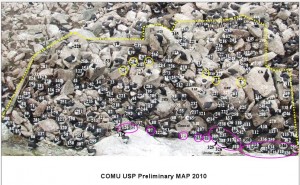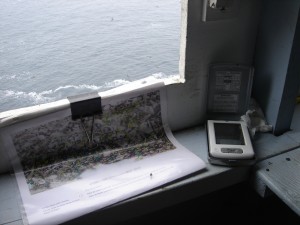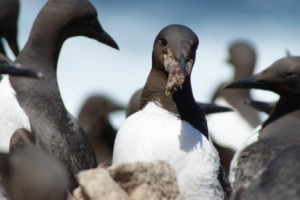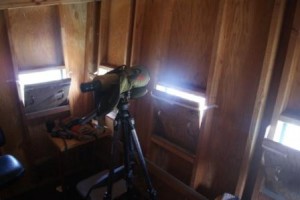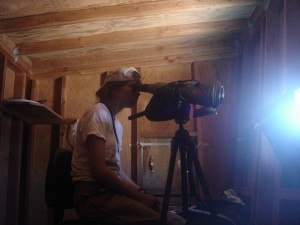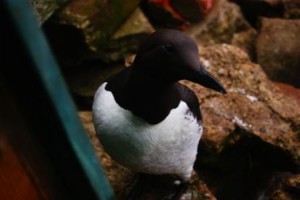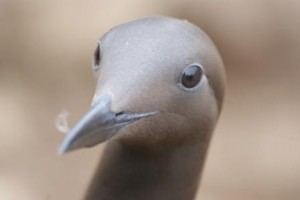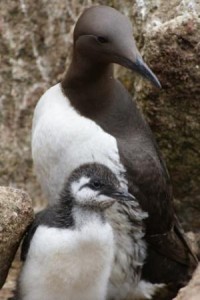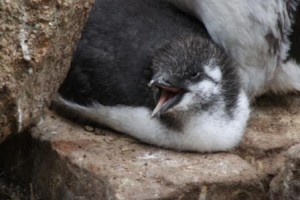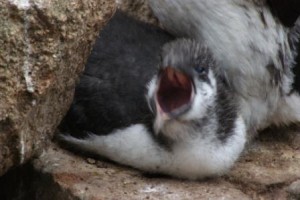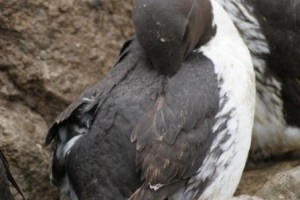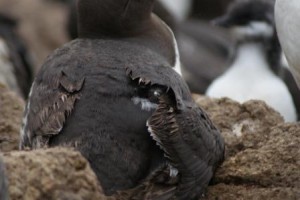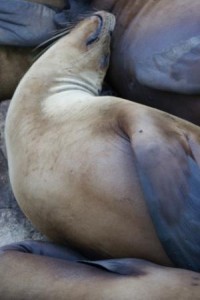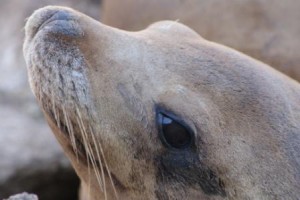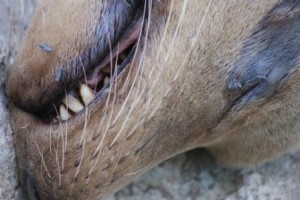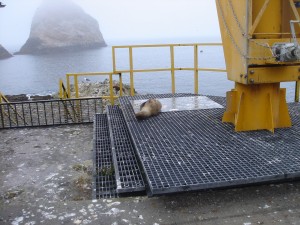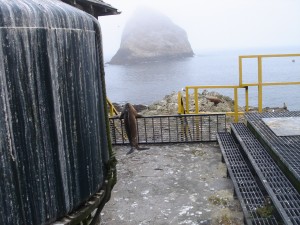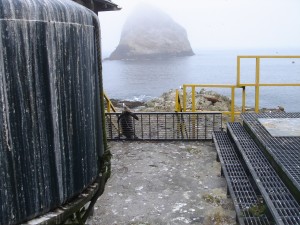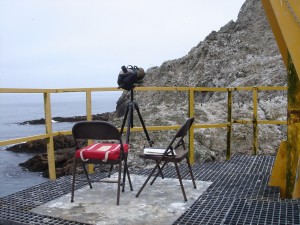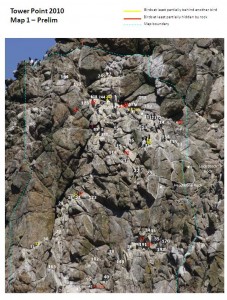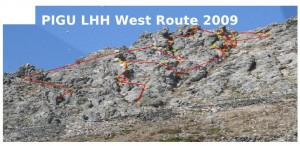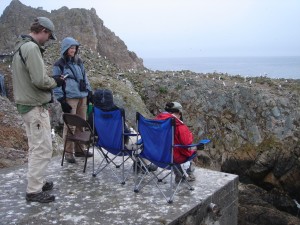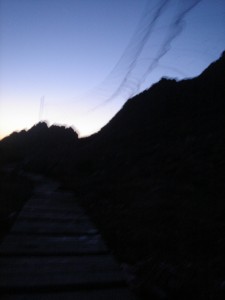So… I haven’t posted in a while… sorry! Things have been incredibley busyyyyy BUT i have pictures for you to make up for my absence!
Our schedules have been very crowded with Murre Diet Watch!
This is the map of the study plot we look at for Diet Watch. Each number represents a mate pair and its egg. As birds fly in with fish, we track which site they go to, what fish they brought in to feed their chick, and if they have bands, what their banding code is.
Diet Watch needs 2 people: 1 primary observer, who is supposed to watch the plot at all times and figure out the information to be recorded, and tells the secondary observer, who inputs the data into the palm pilot (pictured), and who is “back-up” in case more than 1 bird flies in at a time or the primary observer has to blow their nose or wipe their binoculars or double-check the map to figure out which site the bird went to.
We just finished our last all-day diet watch yesterday! yay! but 2 hour diet watches continue daily at consecutive time slots until only 5 chicks remain in the plot.
I’ve also picked up Katrina’s old job of murre census counts at Sea Lion Cove.
this is the inside of the the Sea Lion Cove blind (SLC). Since this blind is unique in that it was built in and amongst the birds, the windows cant be opened all the way without scaring all the birds into flying away, so they’re opened up just a crack. I have a little clicker-counter and there’s about 500-600 murres to count!
this is me looking through the scope to record the bands on Brandts cormorants that I see, and checking for nests and/or eggs
Since the windows are so close to their colony, there are a few wandering murres that get kind of curious and peer into the blind through the window.
It makes for great photo opps!
A lot of them have chicks! They’re getting big and right now many are fledging daily. There are about 250,o00 murres on this island, and if each pair had a chick, that would be about 125,000 chicks! wowzers
i caught this one mid-yawn
“im fat and full of fish!”
a lot of the chicks cuddle up against their parent, and so when you’re checking for chicks at a plot, a lot of the time all you can see is their little beak peeking out from under Mom or Dad’s wing. It must be warm under that wing!
Good job protecting your chick from gulls, murre!
sometimes the Zalouphus (California Sea Lions) hang out and snooze really close to the blind.
Sooooo cute, right?!?
WRONG they are stinky and loud! and when they dominate the area, the birds cant nest because the sea lions will trample them.
this one decided to take a nap on the platform I use to watch Tower Point Murres.
I had to chase him off the platform and down the stairs
But he wasn’t happy about it, and left me a very passive aggressive present – a big pile of stinky poop to shovel away. grrrr
Speaking of tower point, I had promised earlier to tell you all more about that study!
I sit here at North Landing (where boats used to get craned in before the new crane on East Landing) and look through that scope to “take attendance” on the Murres in two study plots across the gulch.
This is a map of one of the plots. I go through each site with my attendance sheet, and write “NP” if a bird is not present, “E” if I see a bird incubating an egg at the site, “C” if I see a bird with its chick at the site, “0” if there is a bird there with nothing under it, and “?” if after the 2 or so hours I spend taking attendance I cannot determine if the bird there has anything. There’s also special notation for when a neighbor attempts to “alloparent”, or sits on its neighbor’s chick or egg and feeds it. I’m not sure why they do that, but it tends to occur with neighbors that lost their chick to predation or egg from a failed hatch. Maybe they’re sad and jealous.
There’s also a second map with about the same number of sites to the left and below this “map 1” but the file was too big to upload. Sorry!
Also, on Saturday, Russ and Annie came back to the island! And a few days ago, Melinda Connors, an intern from 2005, came back for a two-week stint to help us out with our workload! (and cooking =D ) She’s doing a number of things, including daily checks on the Pigeon Guillemots that have been banded in Annie and my study of the PIGU breeding checks.
This is a map of one half of the sites that get checked during the PIGU breeding check that Annie and I do every 5 days. We climb to each site, which are mostly crevices in the rock, and check the contents of the site. If there is a chick, we weigh it and record its feathering status (downy, partly feathered, mostly feathered, or fully feathered), and if its mostly feathered to fully feathered, we band it! Once they get banded, they need to get checked daily to determine what day they fledge.
There is another half of the PIGU check, but I uploaded the wrong file, so I dont have a picture of it to post.. woops! It’s really similar to the other half, it’s just directly east of it and goes directly under the lighthouse. There are also about 25 sites in a old pile of rocks near “Garbage Gulch” that I dont have a picture of… sorry!!!!!!
just kidding! here is most of the crew doing a PIGU diet watch switch at the Garbage Gulch “rubble pile”. We do 2 shifts (7am – 9am and 9am-11am) every 3 days, and switch out turns at 9. PIGU diet watch is similar to Murre diet watch in that we record the site that got fed, the fish they brought in (their diet is a little different from Murres), and if they have bands, their banding combo. It’s a little easier in that their site numbers are painted on the rocks right next to their entrance, but harder because the overall plot is much larger and we’re farther away. We alternate doing diet watch at the Garbage gulch “rubble pile” and at Lighthouse Hill.
Also, we’ve been busy with nightwork!
its hard to get pictures after dark without using flash which we avoid since its not nice to the birds, but here is the setup of the net at around 9pm. We set up the mist-net and have it open usually around 9 and everyone but 2 people lay down by the sides of the net and wait for Rhinocerous Auklets to fly into it. They grab the bird out of the net, someone else picks up all the fish the bird was bringing back to its chick, and puts it into a baggie to process later, and the bird and baggie get “processed” at the house (we take measurements and band it if its new and not if its a recapture).
after we catch 5 incidental Cassin’s Auklets, we close the net, put everything away, and process the fish. We figure out the kind of meal each Rhino was bringing back for its chick by identifying all the fish and taking a few measurements on each fish, and put them in a freezer for more analysis later that we don’t do
Also, last week we netted for Ashy storm-petrels twice since we were in the right moon phase and the wind was under 10 knots (perfect conditions!). It’s easier than Rhino netting since Ashys are soooo tiny and managable but its also more tiring since its a 3 hour session from about 10:30 at night till 1:30 in the morning. I didnt get any pictures since the Ashys are really sensitive to light.
That’s all for now, this post took me 3 days of almost all of my free time to compose and upload pictures! i hope you enjoyed it
love, kristina

